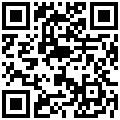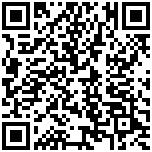
The above is an example of QR Code: a kind of two-dimensional barcode that can be used to encode any sort of textual data. As cameraphones and smartphones become more common in North America, you may see more and more of these. They are already common in Japan. Nokia has a website that lets you make your own mobile codes. You can make a simple business card like this:

URLs, phone numbers, and other sorts of information can be similarly encoded.
Author: Milan
In the spring of 2005, I graduated from the University of British Columbia with a degree in International Relations and a general focus in the area of environmental politics. In the fall of 2005, I began reading for an M.Phil in IR at Wadham College, Oxford.
Outside school, I am very interested in photography, writing, and the outdoors. I am writing this blog to keep in touch with friends and family around the world, provide a more personal view of graduate student life in Oxford, and pass on some lessons I've learned here.
View all posts by Milan



This is definitely one of those ‘network effect’ technologies that only become useful once a critical number of people start using them.
Would my run of the mill phone be able to read this? Would I just take a picture of it?
You need barcode scanning software that includes QR Code support.
Nokia S60 phones include it by default. It is available for Blackberry, iPhone, Android phones, Motorola phones, and others.
For the 2nd QRcode, did you only include your last name?
It saved it as a vCard by default on the iphone but only had your last name, URL and email. It also asked to open the URL in Safari afterward which could be handy for big url… Definitely see the use of such an application.
Newer, smaller, shinier but could the light go out?
http://news.bbc.co.uk/1/hi/technology/8170027.stm
@Hmm, apparently my model either is incompatible or too new to list http://www.mobile-barcodes.com/qr-code-software/
http://www.qrme.co.uk/index.php
Bother
I’m still dubious about the longevity of the Bokode as, unlike barcodes, they require specialised printing and even if the LED issue is overcome (‘the researchers believe the technology could be refined so that tags were reflective and require no power’) they could still easily become corrupt or unreadable due to grime.
One nice thing about QR Codes is that they aren’t just a unique identifier to look up in a database and get a message – they actually contain the message.
That means non-networked devices can read them, and that the disappearance of the company that created them would have no effect on those using them.
For the 2nd QRcode, did you only include your last name?
Nope. It includes first name, last name, email address, and URL. I made another including mailing address and phone number, but didn’t want to post it online.
Another use for QR Codes would be to distribute cryptographic keys in a way that doesn’t require an electronic connection or laborious typing.
For instance, this QR Code contains the key to the message below it, with AES as the encrypting algorithm:
Key:
Ciphertext:
ZZZZZ SKLWE DRLIX EDGSP TFDJE SVVRP CGWQN MGOVK UCIUW RWCPO RBGEO BXWUC HSKPI QIOSC LKIDU CKOLR NFJVU OQHPR EOKXI GDTCP WOVLT DCVDX WMWTV TVJWK ALCGU TBBCC BOOMR PEVPW QSRBV KMJFC FCFRD MUQSP EVBNJ TFUOM BNFPO ERFMO GKMQV JQHDO MKXBN WNPBF JILMN QBDWS AGOGC BRFCM AHWXU BDVTR NITOX DKEFQ GROUW WFOOS TOFIQ WEDRS EONTQ JHRHR KVEKK JWVJS KFCUM FVRER QXBXX LURML AUMMX ILATR VWCBN WDIQB IMLPA WOKGO SAVQP EXOQP KORQB KNJWF FVLKW VWANA SQRSW RHHGB CJJBM AHGFI LQKBU PNKCT BFCKA NKIQD ABECG OCLKX IJDUP VINLX IEBDV JAWKJ SIUTP MWBXE URUCH NLNVV CNQBF ROOQC NDLPU VBOHM XHGVO TEKDU VPINW FXIXF JGNWK WHUOE IBSJX MLHHD ITTVA LEVUU QFICM SEANU QQAKP OHDGE FMIFA HQSGV PJQKQ KUAQH CVBLB UHLSM GMDQL VWRKS VVLQQ CHKKX RRQEC RQPIJ AKATN PJQHL BBBEI JMVBV ICPRJ JTTDK HWMIA AQCVN EXXXI EVOWA PKDEH SBTJV KTCRX UWMDD JFFOC XHALQ KQMMQ LXPHT PXXTQ RFBJA OETXR LQQKM HFTJJ JIWWW IRFHS QBLEE HTNDA QBQHU XXVRR UJBUV OPNFO FVPWO QCSBI VNEBS KDLHK OABPU BDDWK OVNDI KQXWG FGELW NFILA XPDNB UKNNS ULLNF TRLPN WATGM OAPNE ULMPC PXCFB RIHHA MQSEU HWFMW WPGOH TVGWG FUVFO FAOHH MXOWX VFQMW GVKDW VAHBF SLQXT RVTEF WOWEJ GVQOJ FDOWR MEKMP OQQDV EKUQV PPMFL FGVOU GCODH MWNKJ UHEJE WPVTD XTLEC NJLOH OGPPX OGIEM GNLWX XJERQ QIGKC OLXOO BXHTB QHMQH WQXTE QTHIC UXMLN GPMAH KKJVV HVLGI LSTAU SIAXN VBSQD RWLXE LLWRX HKKUB EPUBT SEOMR JVIWT JNDJV VROBA VPGAE MTEXV KVWSR PDDSX LGEOJ CWCUQ PRHCA ARAVX IESUR JOBQD SOXOF HNQQJ XFMAR CIUSV GONTD OJSLQ UKSCC XFDSD HDRLU RSDDP TALJN HLPLW VHGVO QXXPI CKVSF BCFWN AADVG HXAUL SOCTP IPXVW XAXGT CDDBG EPICO SRHRS JJNRR PWXND KHOQM RSBPE STOXP JIPWG WRSEE RVRPF WJEHW GHBPQ IIIHV TMPNN KHDIP DNJPG XSXIZ YYYYY
Neat idea.
To expansions of it:
1) You could put the ciphertext into QR code as well.
2) Someone could write an app for mobile phones that automatically scans a key, scans the ciphertext, and produces plaintext output.
Here is a message encrypted with the key above:
One limitation of using QR codes with ciphertext is that the Nokia page will only accept sixty characters of input. As such, messages need to be kept short. Other software might let you encode more, but phones might not be able to read the resulting image.
60 characters is fine for an encryption key, though.
Someone should make a nice QR Code creator/reader for Macs. It could open files directly, use screen capture, or use the built-in camera.
The only Mac program I have been able to find is in Japanese, but not too tough to figure out.
MIT’s Bokode tech calls out zebra stripes, QR codes for battle of barcode supremacy
By Tim Stevens on tag
Since barcodes are the sign of the devil (must be true, we read it on the interwebs) it’s no surprise that everyone wants to replace ’em. QR codes have been quite popular, allowing people and companies to tag their stuff with colorful decals filled with bits and bytes, and of course RFID tags are still going strong, but a team of researchers at MIT has come up with something better: Bokode. It’s effectively a tiny little retroreflective holograph that is just 3mm wide but, when a camera focused to infinity sweeps across it, the Bokodes become clear and appear much larger, captured in the video below. In this way they can contain “thousands of bits” of data and, interestingly, show positional information too, meaning the camera knows where in 3D space it is in relation to the tag. This, of course, has hundreds of potential applications ranging from grocery shopping to augmented reality, and should lead to new and exciting ways for scholars to interpret/misinterpret Revelations.
Trusted paper key
From Wikipedia, the free encyclopedia
Jump to: navigation, search
A trusted paper key (TPK) is a machine-readable print of a cryptographic key. The printed key can be used to decrypt data, e.g. archives or backup data. A trusted paper key can be the result of an offline private key protocol.
Reading bar codes with mobile phones
Snap it, click it, use it
Aug 20th 2009 | SEATTLE
From The Economist print edition
A new way to deliver information to mobile phones is spreading around the world
NEGOTIATING his way across a crowded concourse at a busy railway station, a traveller removes his phone from his pocket and, using its camera, photographs a bar code printed on a poster. He then looks at the phone to read details of the train timetable displayed there. In Japan, such conveniences are commonplace, and almost all handsets come with the bar code-reading software already loaded. In America and Europe, though, they are only just being introduced.
Actually, calling them bar codes is a bit old-fashioned, because they store information in a two-dimensional (2-D) matrix of tiny squares, dots or other geometric patterns, rather than a stripe of black-and-white lines of varying thickness. When an image of the matrix is captured, software in the phone converts it into a web address, a piece of text or a number. If a number, it is sent to a remote computer which responds with an instruction that tells the phone to perform an action associated with that particular bar code.
In the case of the traveller, this might be calling up a web page on which the train timetable is displayed. Other 2-D bar codes might add an event to a calendar or display a coupon that entitles the bearer to a discount on a hamburger. Indeed, one magazine recently featured a bar code alongside archive images of famous swimsuit models. Lecherous readers who photographed it were rewarded with additional pictures.
Google Chart API
QR codes
QR Codes are a popular type of two-dimensional barcode, which are also known as hardlinks or physical world hyperlinks. QR Codes store text, which can be a URL, contact information, telephone number, even whole verses of poems!
QR codes can be read by any device that has the appropriate software installed. Such devices range from dedicated QR code readers to mobile phones.